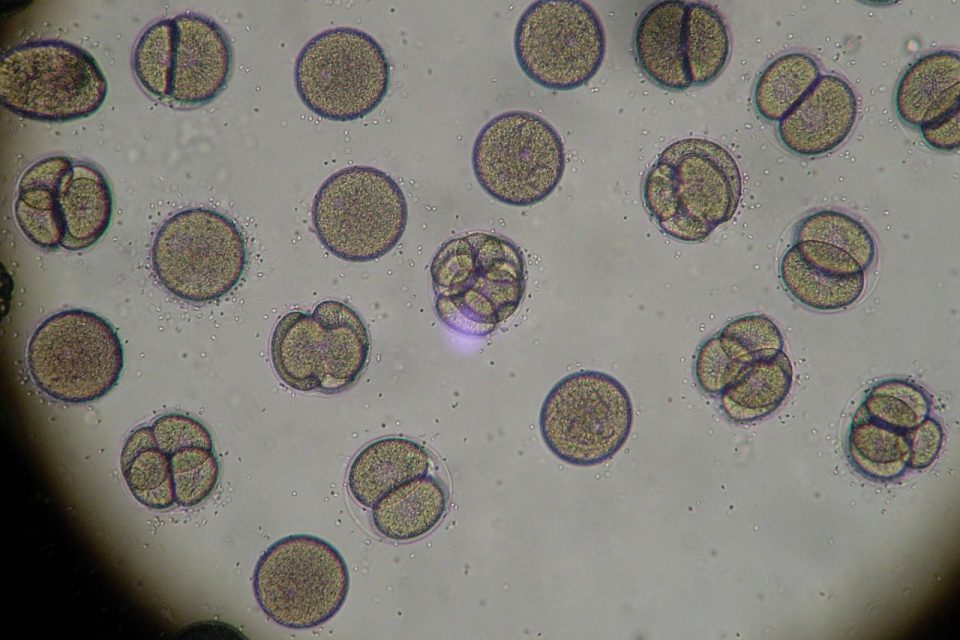The cell walls of plants and fungi differ as plant cell walls contain cellulose while fungal cell walls contain chitin. Plant and fungal cells have cell walls that are responsible for maintaining their shape, protecting them from external damage, and preventing the loss of water.
However, the composition of their cell walls is different. Plant cell walls are primarily composed of cellulose, a complex carbohydrate that provides strength and rigidity to the cell. On the other hand, fungal cell walls contain chitin, a nitrogen-containing polysaccharide that also provides rigidity and strength.
Additionally, fungal cell walls may contain other complex carbohydrates, proteins, and lipids that give them additional properties and functions. Understanding the differences in plant and fungal cell walls is important for various fields including agriculture, medicine, and biotechnology.

Credit: news.cornell.edu
Composition Of Plant Cell Walls
Overview Of Plant Cell Walls
Plant cells have an outer protective layer known as the cell wall, which is rigid, and the major component that gives it strength is cellulose. Cellulose is a long chain of glucose sugars that are connected by beta-1,4 glycosidic bonds.
Description Of The Primary Components Of Plant Cell Walls
Plant cell walls have three primary components: cellulose, hemicellulose, and lignin.
- Cellulose: Cellulose is the most abundant carbohydrate and can be found in cotton, wood, and paper. It gives plants their rigid structure and is an essential component of plant cell walls.
- Hemicellulose: Hemicellulose is a group of complex polysaccharides that provides flexibility and acts as a cementing agent to hold cellulose fibers in place.
- Lignin: Lignin is a complex organic polymer that is one of the main compounds found in wood. It provides additional support and rigidity to the cell wall.
Importance Of Each Component In The Structure And Function Of Plant Cell Walls
Each component of plant cell walls plays an important role in the structure and function of the cell wall.
- Cellulose provides the structure and rigidity, making it the backbone of the plant cell wall.
- Hemicellulose’s flexibility ensures that plants are able to adjust to changes in the environment.
- Lignin increases the strength of the cell wall, giving hierarchical structure, and provides protection against environmental factors such as pests, fungi, and other pathogens.
Understanding the composition of plant cell walls is essential to comprehend the structure and function of plants. It is fascinating how every component plays an essential role in the plant’s growth and survival.
Composition Of Fungal Cell Walls
Overview Of Fungal Cell Walls
Fungi are unique organisms that have cell walls made of different complex carbohydrates and proteins. Unlike plant cell walls, fungal cell walls do not contain cellulose. In general, fungal cell walls provide structural support and protection to the cells, and they are essential for the fungus’s survival.
Description Of The Primary Components Of Fungal Cell Walls
The primary components of fungal cell walls are chitin, glucan, and proteins. Each of these components plays a significant role in the structure and function of fungal cell walls.
- Chitin: Chitin is a polysaccharide made up of n-acetylglucosamine monomers that are linked together. It is a key component that provides mechanical strength, rigidity, and resistance to fungal cell walls.
- Glucan: Glucan is another polysaccharide that is composed of glucose monomers linked together. It is essential for fungal cell walls’ rigidity and acts as a barrier between the cell wall and the cytoplasm.
- Proteins: Proteins constitute the third major component of fungal cell walls. They are responsible for maintaining the cell wall’s integrity and providing flexibility.
Importance Of Each Component In The Structure And Function Of Fungal Cell Walls
The structural and functional attributes of fungal cell walls are highly dependent on their components. Here’s what each component contributes to fungal cell walls:
- Chitin: Chitin is essential for maintaining the structural integrity of fungal cell walls. It also provides protection against environmental threats and enables cell-to-cell communication within the fungus.
- Glucan: Glucan provides rigidity to the cell wall, making it resistant to mechanical stress. In addition, glucan allows the fungus to grow by providing the necessary structural support to the cell.
- Proteins: Proteins provide flexibility to the cell wall, enabling the fungus to grow in different environments. They also play a vital role in the protection of the cell against environmental threats and facilitate the transport of molecules across the cell wall.
The composition of fungal cell walls is unique and essential for the fungus’s survival. It is composed of chitin, glucan and proteins which provide mechanical strength, rigidity, as well as structural support and protection. These characteristics help the fungus maintain its structural and functional integrity, enabling it to grow in diverse environments.
Differences In Structure And Function Of Plant And Fungal Cell Walls
Differences in structure and function of plant and fungal cell walls
Plant and fungal cell walls are the distinguishing features of the two organisms. They serve as a protective and supportive barrier, defining the shape and structure of each cell. While these cell walls share some similarities, they exhibit several structural and functional differences.
We will explore the unique properties of plant and fungal cell walls and how they differ, starting with a comparison of their structures.
Comparison Of The Structure Of Plant And Fungal Cell Walls
Plant cells have a rigid cell wall that is composed of cellulose, hemicellulose, and pectin. These compounds create a meshwork of structures that give the wall its strength and flexibility. The cell wall is made up of three layers:
- Primary cell wall: This is the first layer of the cell wall that is formed during cell growth and development.
- Secondary cell wall: This is the second layer of the cell wall that is formed once the cell is fully developed.
- Middle lamella: This layer is found between adjacent plant cells and is made of pectin.
In contrast, fungal cell walls consist of chitin, which is a long chain polymer of n-acetylglucosamine. Fungal cell walls have two main layers:
- Outermost layer: This layer is composed of glycoproteins, glycolipids, and chitin.
- Innermost layer: This layer is made up of chitin and β-(1,3)-glucans.
Discussion Of The Structural Differences Between The Two Cell Walls And How These Differences Impact The Function Of Each
The structural differences between plant and fungal cell walls lead to unique functional properties. Some of the key differences are:
- Plant cell walls are permeable, allowing for the efficient exchange of nutrients and water between cells. In contrast, fungal cell walls are relatively impermeable, protecting the organism from environmental stressors such as osmotic shock.
- Plant cell walls have a high mechanical strength, enabling the formation of structures such as leaves, stems, and branches. Fungal cell walls are much softer, enabling the organism to absorb nutrients across its surface.
- Plant cell walls are capable of self-repair. When damaged, enzymes are released to break down and repair the damaged region of the cell wall. Fungal cells lack this capability.
Plant and fungal cell walls play important roles in defining the shape and function of each cell. While each cell wall has unique properties to suit its respective organism, they both serve as essential protective barriers and support structures.
Frequently Asked Questions Of How Are Cell Walls Of A Plant And Fungus Different
How Do Plant And Fungi Cell Walls Differ In Structure?
Plant cell walls are made up of cellulose while the cell walls of fungi are predominantly composed of chitin, a tough but flexible polysaccharide that provides structural support and protection.
Why Are Cell Walls Essential For Plant And Fungi Cells?
Cell walls provide rigidity and strength to the cell, protect it from damage and prevent water loss. Plant cell walls also play an important role in growth, development and enabling communication between different cells and tissues.
Can Plant Cells Synthesize Chitin In Cell Walls Like Fungi?
No, plant cells lack the ability to synthesize chitin and instead use other polysaccharides like cellulose, hemicellulose, and pectin to build their cell walls.
How Do Plant And Fungi Cell Walls Resist Different Environmental Stresses?
Plant cell walls are specially designed to resist turgor pressure, resist mechanical stress, and protect against pathogens and pests. Fungal cell walls are generally thicker and harder than plant cell walls providing a rigid structure that supports hyphal growth and significant environmental resistance.
Can The Differences In Cell Wall Structure Between Plant And Fungi Be Used For Biotechnological Applications?
Yes, the differences in cell wall structure have been used in many biotechnological applications such as making paper, generation of biofuels and developing new medicines targeting fungal infections.
Conclusion
Throughout this article, we have explored the difference between the cell walls of plants and fungi. Their structure, composition, and function are unique to each organism, and it is fascinating to see the diversity of life on our planet. The primary function of plant cell walls is to provide structural support to the plant and protect it from external factors.
In contrast, the cell walls of fungi serve as a barrier against the environment and aid in nutrient absorption. It is important to understand these differences to appreciate and comprehend the vital role that these organisms play in our ecosystems.
Further research and studies on the cell walls of plants and fungi can uncover new insights into the evolutionary history and biochemistry of these organisms. The complexity of these structures highlights nature’s remarkable diversity and secrets waiting for us to discover.




